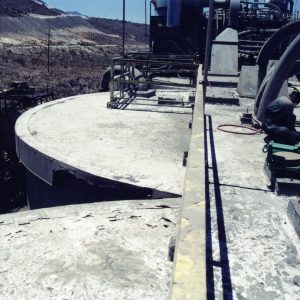Keeping Stored Product Dry Under Difficult Circumstances.
By Mark S. Kuhar
 |
 |
 |
 |
One of the biggest issues for cement companies is keeping product dry. Mitsubishi Mining Co., Lucerne Valley, Calif., had a big problem. Its cement storage silos had leaks. Water seepage and roofing leaks were costing them a lot of money and time.
Water of course turns powdered cement into hardened rock, and one of its storage silos was getting large chunks of this rock in their product. Upon investigation they found that water leakage had caused massive boulders of cement to build up, which were as big as cars, inside of the silos. They were so enormous that explosives and jackhammers had to be used inside the silo to break them down into smaller pieces before they could be removed.
Loss of production plus the time spent dealing with the removal of the build up cost Mitsubishi a lot of money. They needed a solution that would not only stop the leaks, but also stand up to the harsh environment of the hot desert and mining conditions. During the winter they can get more than 60 in. of rain some years and during the summer the temperatures can climb higher than 100 degrees.
Rubberized Emulsion and Polyester
Century Roofing 3 Generations introduced Mitsubishi Mining to a tough waterproofing system that could take the abuse that was dished out from the mining operation as well as the harsh desert climate, and continue to stay watertight. The system uses rubberized emulsion, polyester ply sheets and final layer of white acrylic coating.
On top of the storage silos a large layer of hard cement had built up over the years. This needed to be removed before waterproofing the deck. Jackhammers were used on the larger pieces of cement and needle guns and grinders removed the material off of the roof deck, perimeter and equipment – a very expensive and time-consuming process.
Perimeter metal and flashings were primed and two layers of an elastomeric compound and polyester were applied.
The original concrete deck was irregular. After the deck was primed, 6 gal. per 100 sq. ft. of rubberized emulsion was applied to the roof deck followed by one layer of soft polyester.
This process was repeated for a total of two layers. Using soft polyester allowed for the waterproofing system to mold to the concrete deck avoiding any air pockets or voids. A final coating of 6 gal. per 100 sq. ft. of rubberized emulsion completed this phase of the job.
Cool White Roof Coating
After the rubberized roof cured, an acrylic coating was applied using three separate coats. The acrylic coating blocks 100% of the suns UV rays and protects the new system from the hot desert sun. It will also stretch along with the rubberized material underneath, giving the roof flexibility.
Once the whole roof system was complete a walking deck was installed to all the high foot traffic areas. Upon completion Mitsubishi Mining received a 10-year warranty, and the job came in on time and on budget.
Century Roofing has been using rubberized emulsion and acrylics for three generations. and combining them with tough polyester reinforcement material for more than 30 years. The company has done jobs for CalPortland, National Cement and most recently for Lehigh Hanson at the Port of Los Angeles.
Information for this article courtesy of Century Roofing 3 Generations, www.thecenturyroofing.com.




